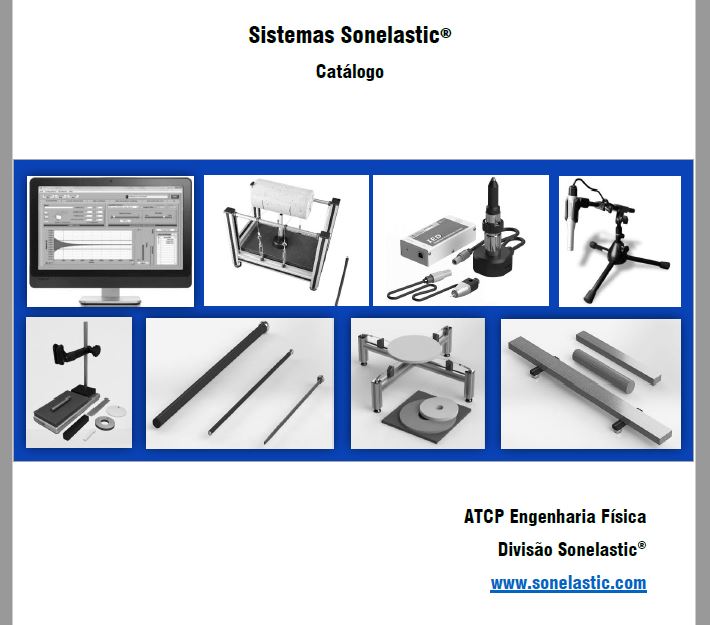Modulus of elasticity and Poisson's coefficient of ferrous metals
The tables below show the values of Young's modulus (modulus of elasticity) and Poisson's ratio at room temperature for several ferrous metals used in engineering. The material's properties are expressed in average values or in ranges that can vary significantly depending on the processing and the material's quality. The exact values can be measured by the non-destructive Sonelastic® Systems.
Cast Iron
| Material | Modulus of elasticity | Poisson’s ratio | |
| GPa | 106 psi | ||
| Cast irons | |||
| Gray iron, grade G1800: | 66-97 | 9.6-14 | 0.26 |
| Gray iron, grade G4000: | 110-138 | 16-20 | 0.26 |
| Ductile iron, grade 60-40-18: | 169 | 24.5 | 0.29 |
| Ductile iron, grade 80-55-06: | 168 | 24.4 | 0.31 |
| Ductile iron, grade 120-90-02: | 164 | 23.8 | 0.28 |
| Values for reference only. For exact values, characterize the material with the Sonelastic® Systems. | |||
Main applications:
- Grade G1800: applied where the resistance is not critical.
- Grade G4000: blocks and pistons of motors.
- Grade 60-40-18: pieces that work under pressure, such as valves and pumps.
- Grade and Classes 80-55-06 120-90-02: Gears and high resistance components.
The gray irons have high damping, which is a desirable feature for pieces and structures subjected to vibration, and high resistance to wear despite being fragile. Furthermore, it is one of the cheapest metallic materials. The nodular irons are more ductile and resistant than gray irons, and have similar properties to steel.
The quality control and nodularity evaluation can be performed by measuring the damping and vibration of the material. The damping and the elastic moduli (Young's Modulus, Shear modulus and Poisson's ratio) can be characterized simultaneously and accurately by the non-destructive Sonelastic® Systems testing at room temperature, as well as at low and high temperatures.
The knowledge of exact values is vital for the optimization of the material's use and for the reliability of simulations via finite elements. Elastic moduli and damping chracterizations are also employed in the engineering of new variations of these materials.
Stainless steels
| Material | Modulus of elasticity | Poisson’s ratio | |
| GPa | 106 psi | ||
| Stainless steels | |||
| Stainless alloy 304: | 193 | 28 | 0.30 |
| Stainless alloy 316 and 316L: | 193 | 28 | 0.30 |
| Stainless alloy 440 A: | 200 | 29 | 0.30 |
| Stainless alloy 17-7PH: | 204 | 29.5 | 0.30 |
| Values for reference only. For exact values, characterize the material using the Sonelastic® Systems. | |||
Main applications:
- Stainless steel 304: equipment for food industry.
- Stainless steel 316 and 316L: equipment with demand for high reliability solders.
- Stainless steel 440 A: items of cutlery, surgical instruments and bearings.
- Stainless Steel17-7PH: stainless springs.
Forming processes applied to these materials increase the elastic moduli and damping, which can be accurately characterized by the non-destructive Sonelastic® Systems testing, at room temperature, as well as at low and high temperatures and/or cure time. The knowledge of exact values is vital for the optimization of the material's use and for the reliability of simulations via finite elements. Elastic moduli and damping characterizations are also employed in the engineering of new variations of these materials.
Common steels and low-alloy steel
| Material | Modulus of elasticity | Poisson’s ratio | |
| GPa | 106 psi | ||
| Stainless steels | |||
| A36 steel | 207 | 30 | 0,30 |
| Stainless alloy 316 and 316L: | 207 | 30 | 0,30 |
| Stainless alloy 440 A: | 207 | 30 | 0,30 |
| Stainless alloy 17-7PH: | 207 | 30 | 0,30 |
| Values for reference only. For exact values, characterize the material using the Sonelastic® Systems. | |||
Forming processes applied to these materials increase the elastic moduli and damping, which can be accurately characterized by the non-destructive Sonelastic® Systems testing, at room temperature, as well as at low and high temperatures. The knowledge of exact values is vital for the optimization of the material's use and for the reliability of finite elements analyses (FEA). Elastic moduli and damping characterizations are also employed in the engineering of new variations of these materials.
References
ASM Handbooks, Vol. 1 and 2, Engineered Materials Handbook, Vol. 1 and 4, Metals Handbook: Properties and Selection: Nonferrous Alloys and Pure Metals, Vol. 2, 9th edition, and Advance Materials and Processes, Vol. 146, No.4, ASM International, Materials Park, OH.

